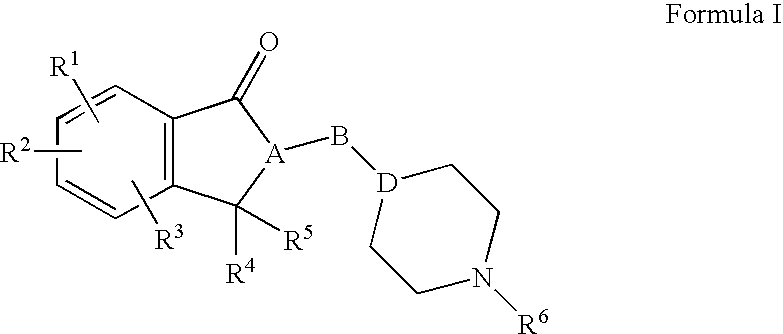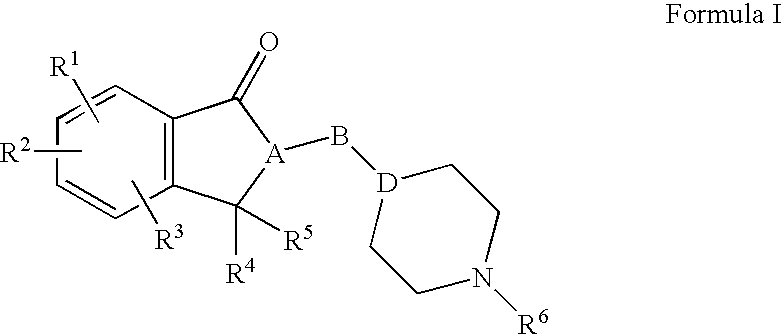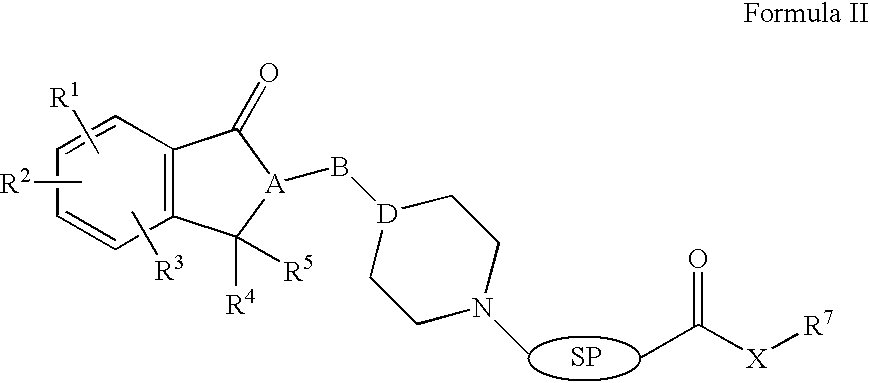Compositions, synthesis, and methods of using indanone based cholinesterase inhibitors
a technology of cholinesterase inhibitors and derivatives, which is applied in the field of synthesis of indanone derivatives, can solve the problems of no cure for this disease, no cure, and serious consequences, and achieves good acetylcholinesterase inhibitory activity, less adverse side effects, and more effective and safer treatment.
- Summary
- Abstract
- Description
- Claims
- Application Information
AI Technical Summary
Benefits of technology
Problems solved by technology
Method used
Image
Examples
example 1
Synthesis of 5,6-dimethoxy-2-(piperidin-4-ylmethyl)-2,3-dihydro-1H-inden-1-one 12 (Scheme 4)
[0176]To a stirred suspension of palladium, 10 wt. % on activated carbon (4 g) in methanol (25 ml) at room temperature under nitrogen atmosphere was added a solution of indanone 11 (0.01 mol, 4.1 g) in methanol (25 ml) followed by ammonium formate (0.07 mol, 4.40 g). The resulting mixture was refluxed for 3 hours. The progress of the reaction was monitored by TLC. The reaction mixture was cooled to room temperature and filtered through a Celite® pad. The filtrate was concentrated on rotavapor and the residue was diluted with DCM (150 ml). The DCM solution was washed with water, dried over anhydrous sodium sulfate (Na2SO4) and evaporated the solvent. The residue was triturated with hexane to give the target indanone 12 as white solid in 97% yield (2.80 g). 1H NMR (400 MHz, CDCl3): δ 1.16-0.92 (3H, m); 1.58-1.40 (3H, m); 1.70-1.64 (1H, m); 2.51-2.39 (4H, m); 2.77 (1H, broad s); 2.92-2.87 (2H, m...
example 2
Ethyl 3-((4-((5,6-dimethoxy-1-oxo-2,3-dihydro-1H-inden-2-yl)methyl)piperidin-1-yl)methyl)benzoate 14a (Scheme 4)
[0177]To a stirred solution of indanone 12 (0.001 mol) and DIEA (0.002 mol) in anhydrous acetonitrile (10 ml) was added a solution of halide 13a (0.0012 mol) in anhydrous acetonitrile (2 ml) at room temperature. The resulting mixture was heated at 55-60° C. for 12 hours. The progress of the reaction was monitored by TLC. The reaction mixture was concentrated on rotavapor and the residue was diluted with ethyl acetate (50 ml). The resulting ethyl acetate solution was washed with water, dried over anhydrous sodium sulfate (Na2SO4) and evaporated the solvent. The residue was purified by silica gel column chromatography using a gradient of 0 to 100% ethyl acetate and hexane to get the title indanone 14a in 74% yield (0.33 g) yield. 1H NMR (400 MHz, CDCl3): δ 1.33-1.28 (3H, m); 1.37 (3H, t, J=7.2 Hz); 1.51-1.42 (1H, m); 1.73-1.62 (2H, m); 1.99-1.85 (3H, m); 2.69-2.65 (2H, m); 2...
example 3
[0178]Isopropyl 3-((4-((5,6-dimethoxy-1-oxo-2,3-dihydro-1H-inden-2-yl)methyl)piperidin-1-yl)methyl)benzoate 14b was synthesized by reacting compounds 12 and 13b according to the procedure described for 14a in Example 2 (Scheme 4). The indanone 14b was isolated as colorless thick liquid in 81% (0.37 g) yield. 1H NMR (400 MHz, CDCl3):δ 1.33-1.28 (3H, m); 1.35 (6H, d, J=6.4 Hz); 1.51-1.40 (1H, m); 1.72-1.62 (2H, m); 2.00-1.85 (3H, m); 2.68-2.65 (2H, m); 2.88-2.83 (2H, broad t); 3.23-3.17 (1H, m); 3.51 (2H, s); 3.87 (3H, s); 3.93 (3H, s); 5.22 (1H, quintet, J=6.0 Hz); 6.83 (1H, s); 7.14 (1H, s); 7.35 (1H, td, J=7.6, 2.4 Hz); 7.51 (1H, broad d); 7.89 (1H, dd, J=7.6, 1.2 Hz); 7.92 (1H, broad s). MS (ESI): m / z=466.30 (M+H+).
PUM
| Property | Measurement | Unit |
|---|---|---|
| enantiomeric excess | aaaaa | aaaaa |
| enantiomeric excess | aaaaa | aaaaa |
| enantiomeric excess | aaaaa | aaaaa |
Abstract
Description
Claims
Application Information
 Login to View More
Login to View More - R&D
- Intellectual Property
- Life Sciences
- Materials
- Tech Scout
- Unparalleled Data Quality
- Higher Quality Content
- 60% Fewer Hallucinations
Browse by: Latest US Patents, China's latest patents, Technical Efficacy Thesaurus, Application Domain, Technology Topic, Popular Technical Reports.
© 2025 PatSnap. All rights reserved.Legal|Privacy policy|Modern Slavery Act Transparency Statement|Sitemap|About US| Contact US: help@patsnap.com



